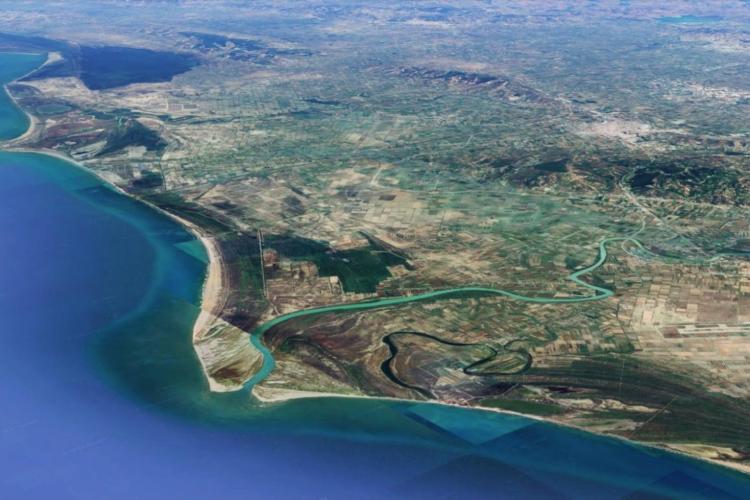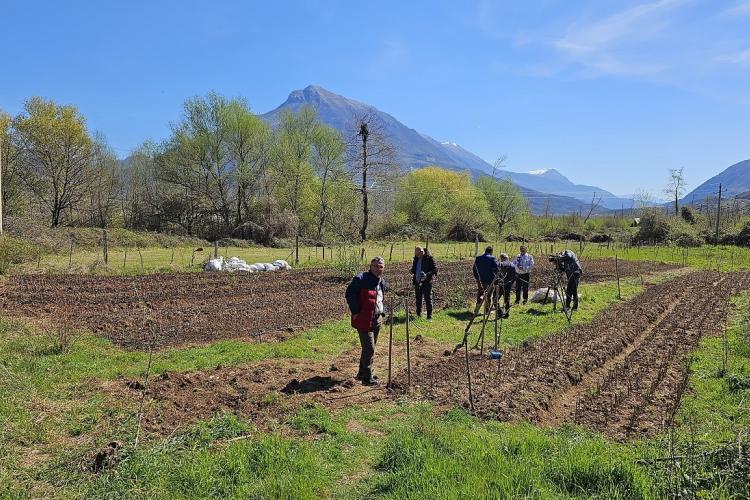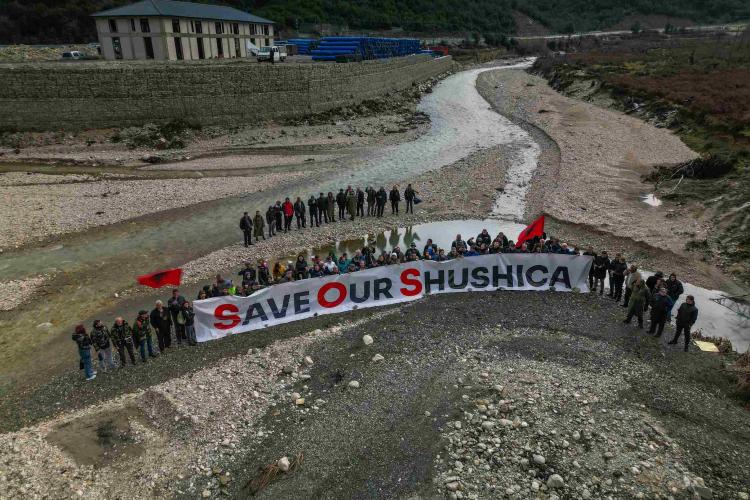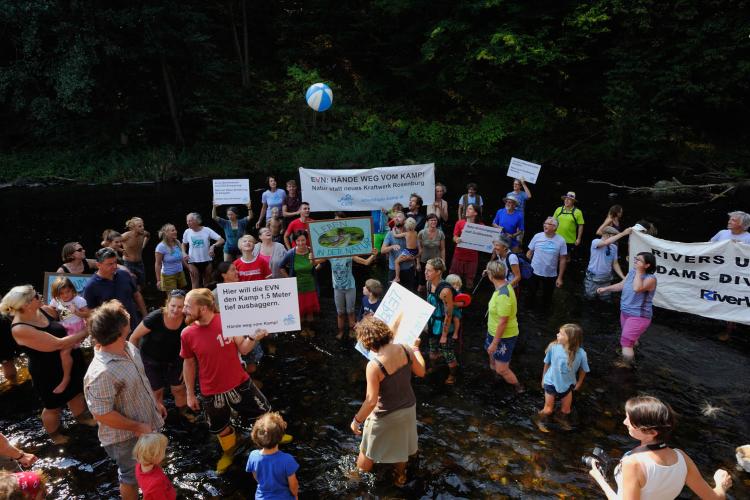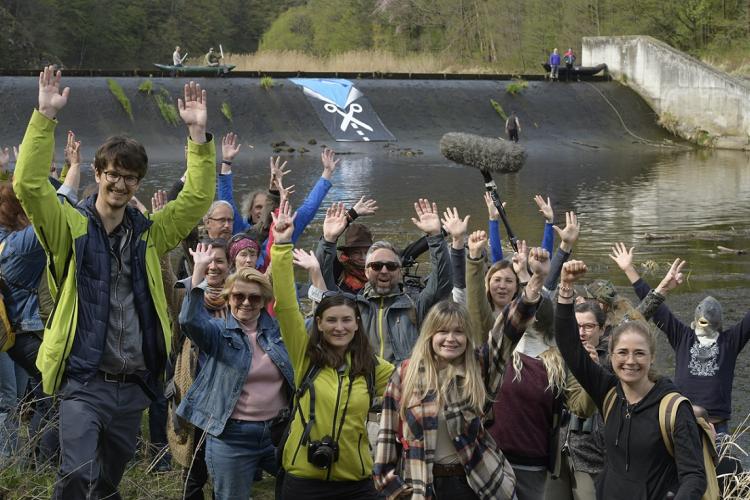US – Dam Removal Movement
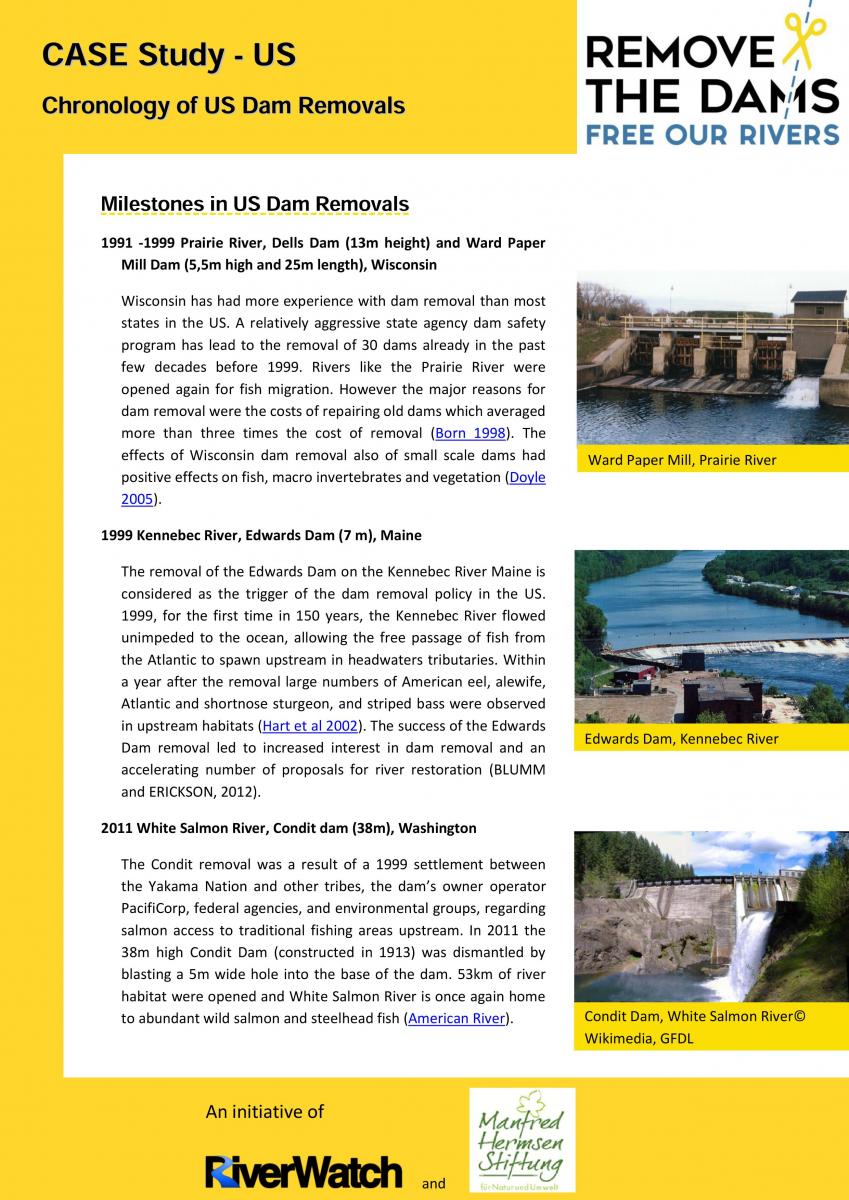 In the US, dam removal for river restoration has been implemented on a large scale for many years. During the Clinton presidency (1993 to 2001), environmental protection has gained political popularity and dam removal was recognized as a viable river restoration method. The year 1999 marked a major event in the US dam removal history: it was the first time that the federal government ordered the destruction of a dam (Edwards Dam 7m height, Kennebec River, Klein 1999, Maine) despite the objection of its owner!
In the US, dam removal for river restoration has been implemented on a large scale for many years. During the Clinton presidency (1993 to 2001), environmental protection has gained political popularity and dam removal was recognized as a viable river restoration method. The year 1999 marked a major event in the US dam removal history: it was the first time that the federal government ordered the destruction of a dam (Edwards Dam 7m height, Kennebec River, Klein 1999, Maine) despite the objection of its owner!
Key data of the US Dam Removal Movement:
- 1300 dams and weirs have been removed by 2016. (Dam Removal Database)
- 38,600km of rivers have been reconnected as a consequence.
- 219,000 jobs in the recreation and tourism industries were created. (Jewell, 2016)
- 11 billion USD in economic value was generated in local communities. (Jewell, 2016)
- Fish stocks have recovered remarkable, as in the case of the Veazie and Great Works Dam removal at the Penobscot River in 2014: River Herring stocks had decreased over decades to less than 1000 individuals, however,
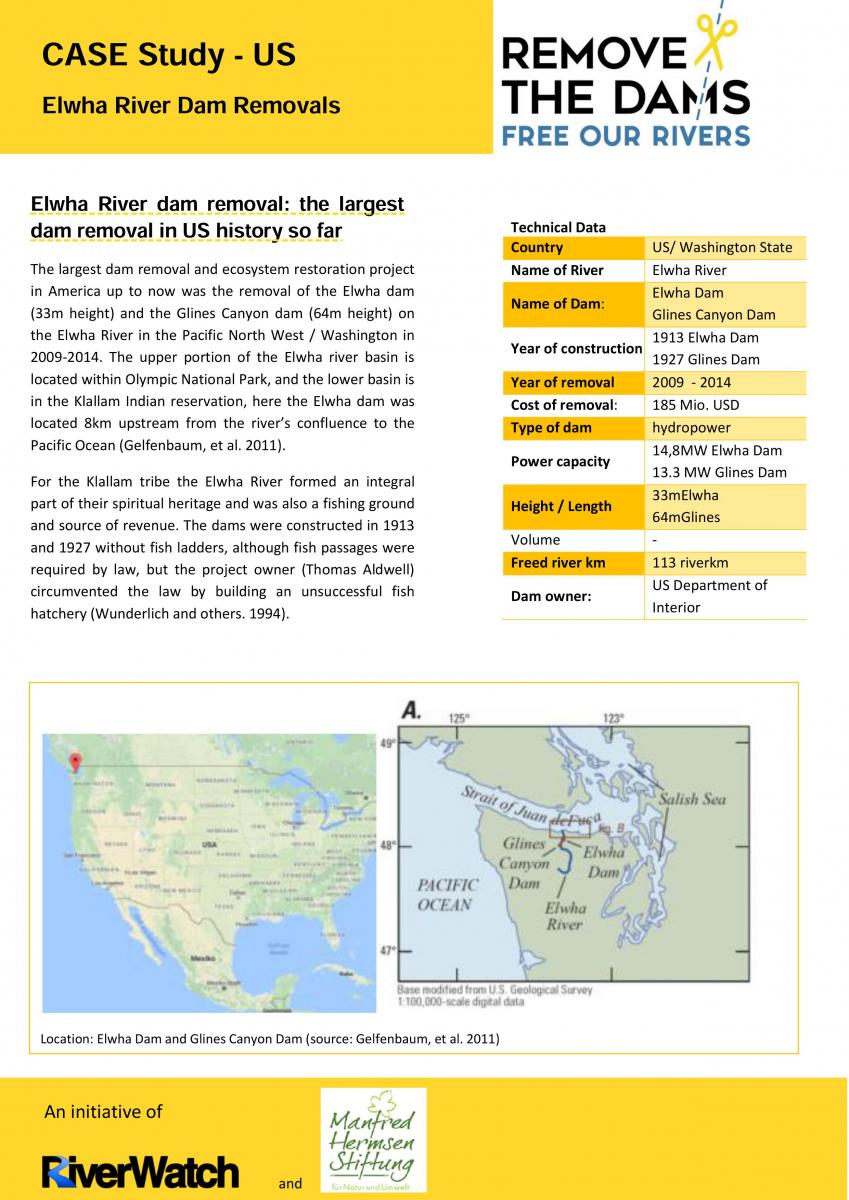 after dam removal and restoration, the fish species found its way back to its natural spawning grounds and over 1.8 Million (!) individuals were counted only 2 years after. (Royte, 2016, DRE Conference)
after dam removal and restoration, the fish species found its way back to its natural spawning grounds and over 1.8 Million (!) individuals were counted only 2 years after. (Royte, 2016, DRE Conference) - After dam removals on, Florida, in 1987, diversity of aquatic species nearly doubled from 34 to 61 species. (American Rivers and Bednarek 2002)
- 64m was the height of the Glines Dam on the Elwha River, the largest dam removal ever in the US history. Further information can be found in the Case Study US.
- 87,000 dams are registered in the US Army Corps, National Dam Databank (dams above 6 feet/1.83m height), 2,100 of which are hydropower plants.
- According to estimations of the US Environmental Agency (EPA 2016), an additional of 2 to 2.5million small and medium sized dams exist, e.g. for fishing and irrigation ponds, or old mill dams. Many of these dams have long since lost their original beneficial use or purpose and may be aging and becoming structurally unsound.
- Outlook: At the Klamath River in Oregon and California, which was once one of the most important rivers with Salmon occurrences in the US, the four largest dams (Glen Canyon Dam 710feet/210m high) are planned to be removed by 2020, which will reconnect 676 river kilometers. This will be the largest dam removal project in the world.
- Even larger would be the removal of 4 large dams on the Snake River a tributary of the Columbia River. Negotiations for dam removal permission are ongoing.
For further information on the US dam removal movement, find our Case Studies:
Case Study - US: Chronology of US Dam Removals
Case Study - US: Elwha River
France - Dam Removal Movement
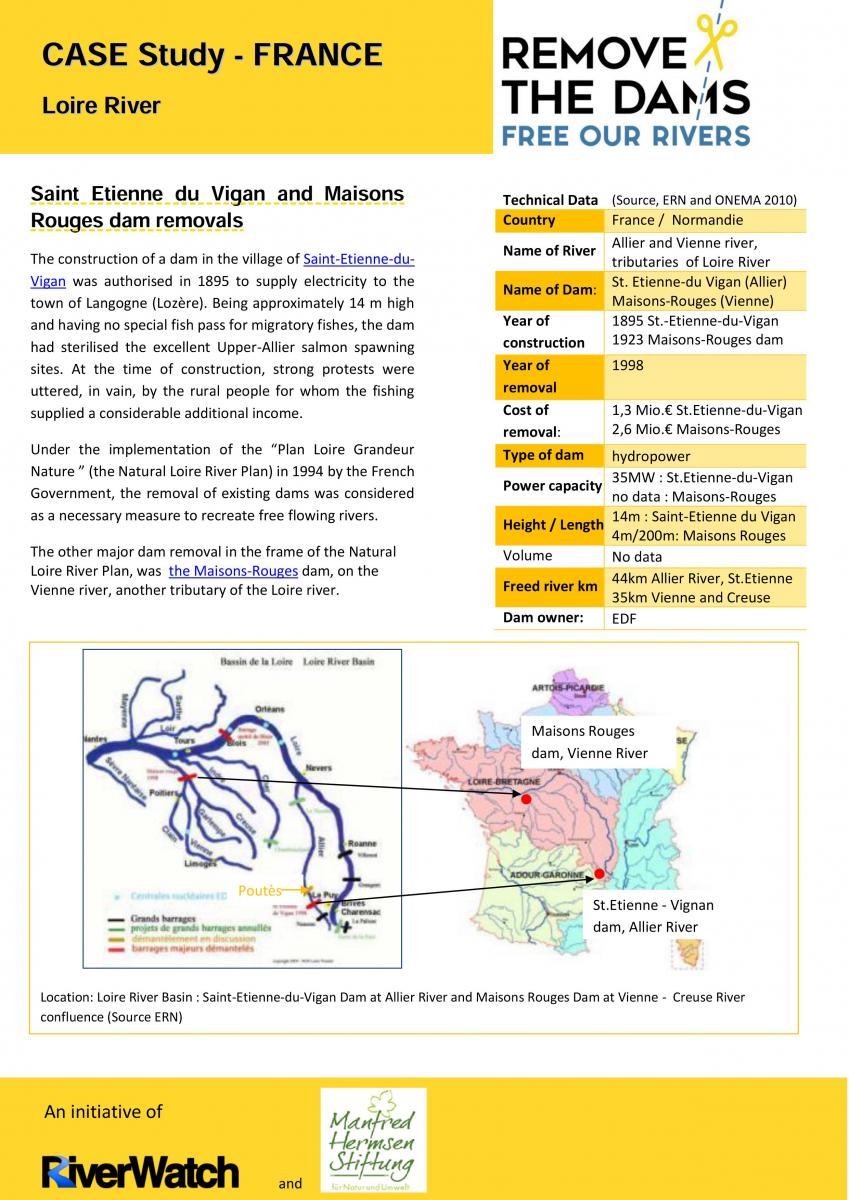 In France, dam removal started in the mid-1990s, triggered by the shocking collapse in the populations of migrating fish, in particular the Atlantic salmon. Between 1996 and 1998, three larger dams (Kernansquillec Damm/ Léguer River, St. Etienne-du Vigan Dam/Allier River and Maisons-Rouges Dam/Vienne River) were removed in the Loire River basin (see Case Studies France), many others followed. According to experts’ estimations, approximately 1,800 dams have already been removed in France. The “SOS Loire Vivante” campaign on the Loire and its tributary Allier played an important role in the French dam removal movement. In the year 1989, several hydropower plants were planned to be constructed in the Loire Valley and its tributaries. Under the “Loire Vivante” many well-known national and international environmental organizations joined their forces to prevent the construction of these plants. After years of construction site occupation, demonstrations, successful lawsuits and intensive awareness rising in national and international media, the construction plans were stopped and the restoration of the river system was decided instead. In 1998, the “Plan Loire Grandeur Nature” – a river restoration and protection plan for the Loire basin – was enacted. This plan prohibited the construction of new dams. Furthermore, the plan stipulates the successive elimination of existing barriers in the river basin in order to establish a free passage of Atlantic salmon and other fish species.
In France, dam removal started in the mid-1990s, triggered by the shocking collapse in the populations of migrating fish, in particular the Atlantic salmon. Between 1996 and 1998, three larger dams (Kernansquillec Damm/ Léguer River, St. Etienne-du Vigan Dam/Allier River and Maisons-Rouges Dam/Vienne River) were removed in the Loire River basin (see Case Studies France), many others followed. According to experts’ estimations, approximately 1,800 dams have already been removed in France. The “SOS Loire Vivante” campaign on the Loire and its tributary Allier played an important role in the French dam removal movement. In the year 1989, several hydropower plants were planned to be constructed in the Loire Valley and its tributaries. Under the “Loire Vivante” many well-known national and international environmental organizations joined their forces to prevent the construction of these plants. After years of construction site occupation, demonstrations, successful lawsuits and intensive awareness rising in national and international media, the construction plans were stopped and the restoration of the river system was decided instead. In 1998, the “Plan Loire Grandeur Nature” – a river restoration and protection plan for the Loire basin – was enacted. This plan prohibited the construction of new dams. Furthermore, the plan stipulates the successive elimination of existing barriers in the river basin in order to establish a free passage of Atlantic salmon and other fish species.
Further information on the French dam removal movement can be found in our Case Study or on the ERN website:
 Case Study - France: Loire
Case Study - France: Loire
European Rivers Network
Spain - Dam Removal Movement
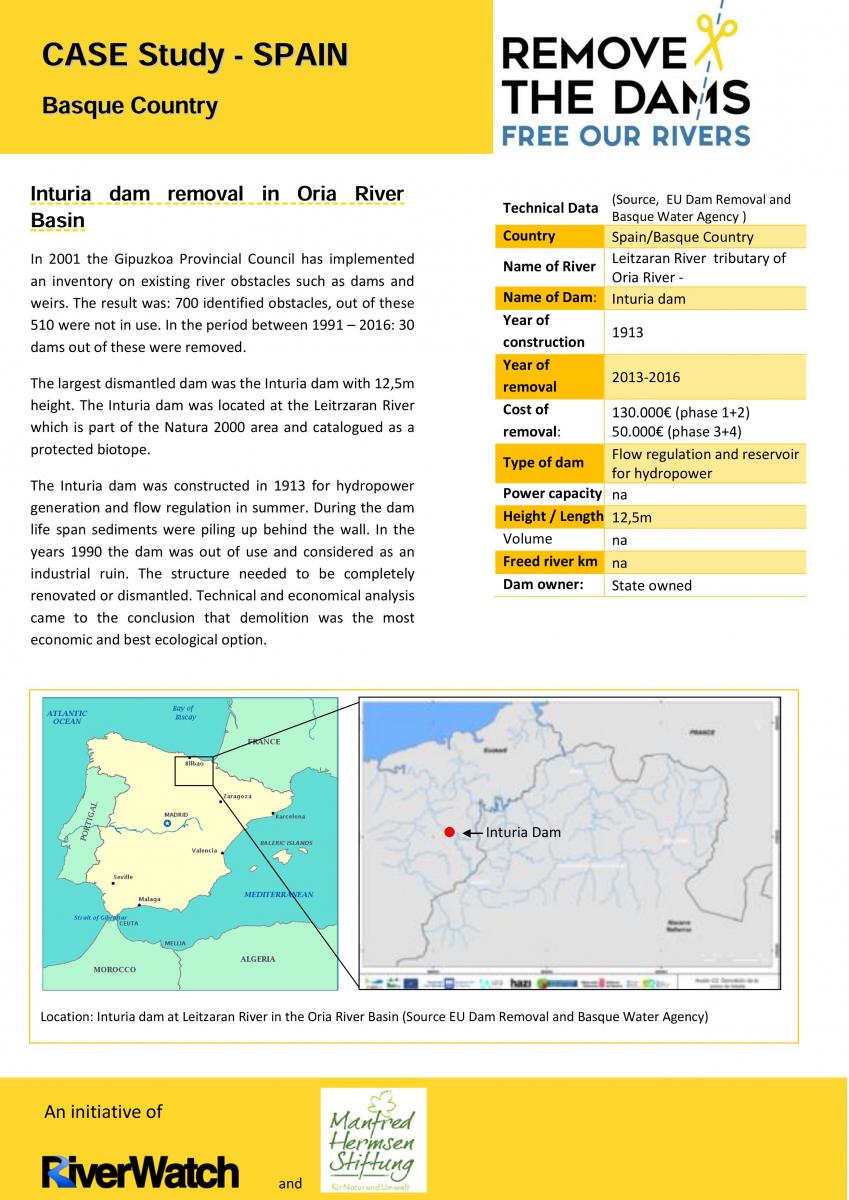 In Spain, as in other EU countries, the re-establishment of rivers’ connectivity is a legal obligation according to the EU-Water Framework Directive. The Spanish government is supporting the removal of existing barriers which are out of use and where water permits are expiring. According to experts’ estimates, over 200 dams have been removed in Spain so far:
In Spain, as in other EU countries, the re-establishment of rivers’ connectivity is a legal obligation according to the EU-Water Framework Directive. The Spanish government is supporting the removal of existing barriers which are out of use and where water permits are expiring. According to experts’ estimates, over 200 dams have been removed in Spain so far:
- Basque Water Authority: 20 dam removal projects implemented so far, like the Inturia dam (12m), removal 2013-2016 (see our Case Study Spain). In the Bidasoa River system, 5 dams have been removed until 2008 and about 500 water use permits in this basin were canceled in order to protect salmon and brown trout. The Bidasoa River restoration project is strongly supported by the Spanish NGO Rios Con Vida who is advocating with the WWF for dam removals in Spain.
- Duero River Basin: Retuerta dam (14m), removal 2013, (watch the removal video) and Gotera dam (ca. 8m) in the Alto Bernesga Biosphere Park, removal 2011 (watch the removal video).
- Tagus River Basin: Robledo de Chavela dam (ca. 10m), removal 2013 (watch the removal video).
- Guadaira River: 25 dam removals from 2008 - 2016.
- Güeña River in the National Park „Picos de Europa“: 2 dam removals between 2008-2016.
Further information on Spanish dam removals can be found in our Case Study :
Case Study - Spain: Basque Water Agency
Germany - Start of Dam removals
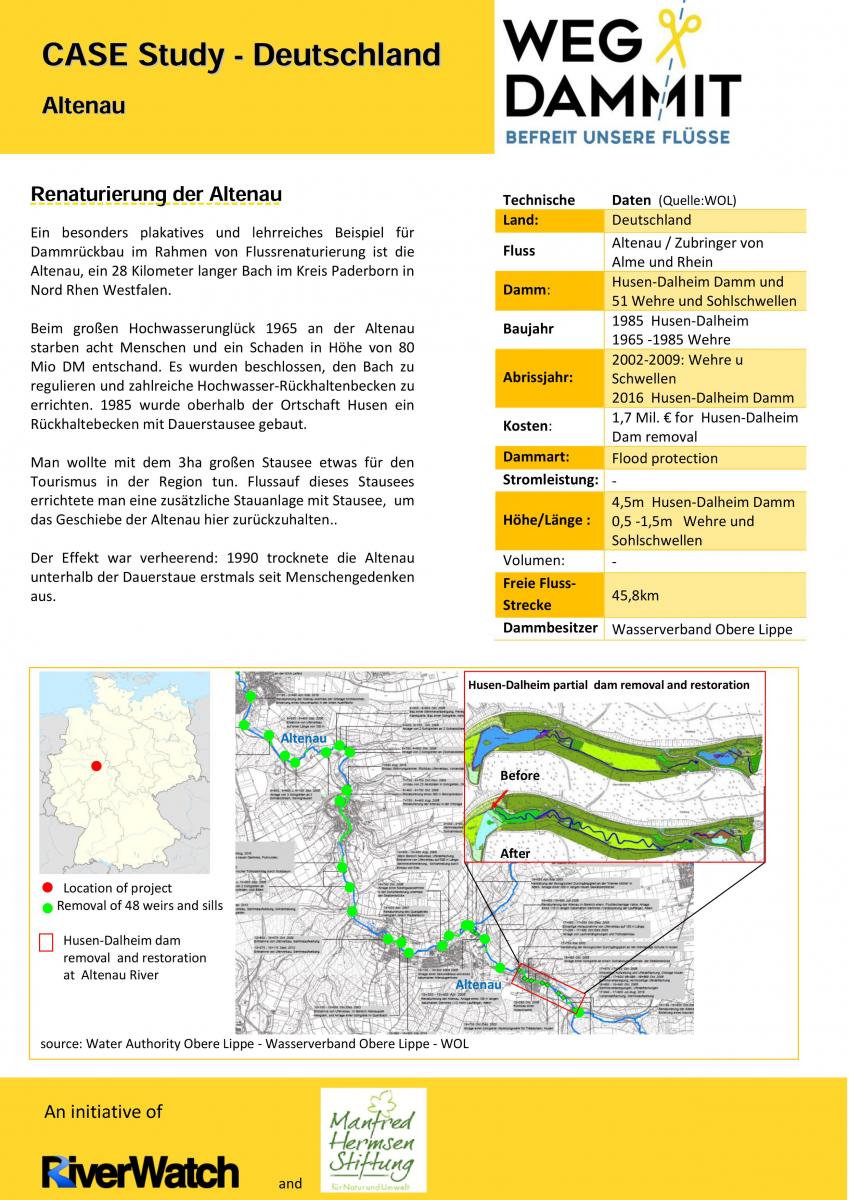 In Germany, dam removal has been implemented as restoration measure particularly for small dam such as weirs or sills. In total 5,150 measures to mitigate the loss of connectivity caused by barriers are planned, according to the UBA (Environmental Agency 2016). Not only dam removals but also the equipment of existing dams with fish passages is counted amongst these measures. These fish passages have however a rather low success rate (more information on this topic in the Conceptpaper). Detailed data on the number of removed dams is not available; experts estimate that approximately 1000 small dams have already been removed. A particularly striking and instructive example of river restoration in Germany is the restoration of the Altenau River, a 28 kilometer long stream in the district of Paderborn in North Rhine-Westphalia.
In Germany, dam removal has been implemented as restoration measure particularly for small dam such as weirs or sills. In total 5,150 measures to mitigate the loss of connectivity caused by barriers are planned, according to the UBA (Environmental Agency 2016). Not only dam removals but also the equipment of existing dams with fish passages is counted amongst these measures. These fish passages have however a rather low success rate (more information on this topic in the Conceptpaper). Detailed data on the number of removed dams is not available; experts estimate that approximately 1000 small dams have already been removed. A particularly striking and instructive example of river restoration in Germany is the restoration of the Altenau River, a 28 kilometer long stream in the district of Paderborn in North Rhine-Westphalia.
Further information on German dam removals can be found here (currently only in German):
Dam Removal Guidelines
Coming soon
In the US, many States already have dam removal guidelines. One example is the Guidebook for Dam Removals by American Rivers
Database on dam removals in Europe
The Dam Removal Europe Initiative is generating a database of dams removed in Europe. Data from dam removals in Spain, UK, Sweden and Finland have already been uploaded and are displayed in a map. Our campaign will contribute dam removals data from our project area in particular the Alpine and the Balkan region.
Source: http://damremoval.eu/dam-removal-map-europe/
Number of dams and barriers in Europe
According to the European Environmental Agency Report (EEA Report No 8/2012), there are several hundred thousand barriers and transverse structures in European rivers. Some of them are large dams for hydropower production or irrigation storage reservoirs, but the majority is comprised of smaller obstacles like weirs, for example old mills or sills for flood protection.
Currently, an obstacle is located per every second kilometer in Germany, every kilometer in Austria and every 650m in Switzerland! These obstacles are disrupting the free flow of our rivers and are trapping sediments, fish and aquatic organisms into disconnected pools.
The report of the European water assessment can be found here: EEA report 2012
Large Rivers of the Danube Basin
In the Danube Basin, a total of 1,688 barriers are located on large rivers with catchment areas greater than 4,000 km². Out of these, only 756 are currently reported as being equipped with functional fish migration aids. Therefore, 932 continuity interruptions (55 %) remain a hindrance for fish. (ICPDR, 2009, Source EEA report 2012) The effects are disturbing: eel, grayling, salmon, huchen, sturgeon and many other species are highly threatened, not to mention the sensitive water insects (macrozoobenthos).
Germany
In Germany there are currently thought to be some 200,000 transverse structures. In relation to the overall length of Germany's network of watercourses (approximately 400,000 km), the continuity of rivers is therefore interrupted by a technical structure at around every second kilometer. (UBA, Deutschland 2016)
Austria
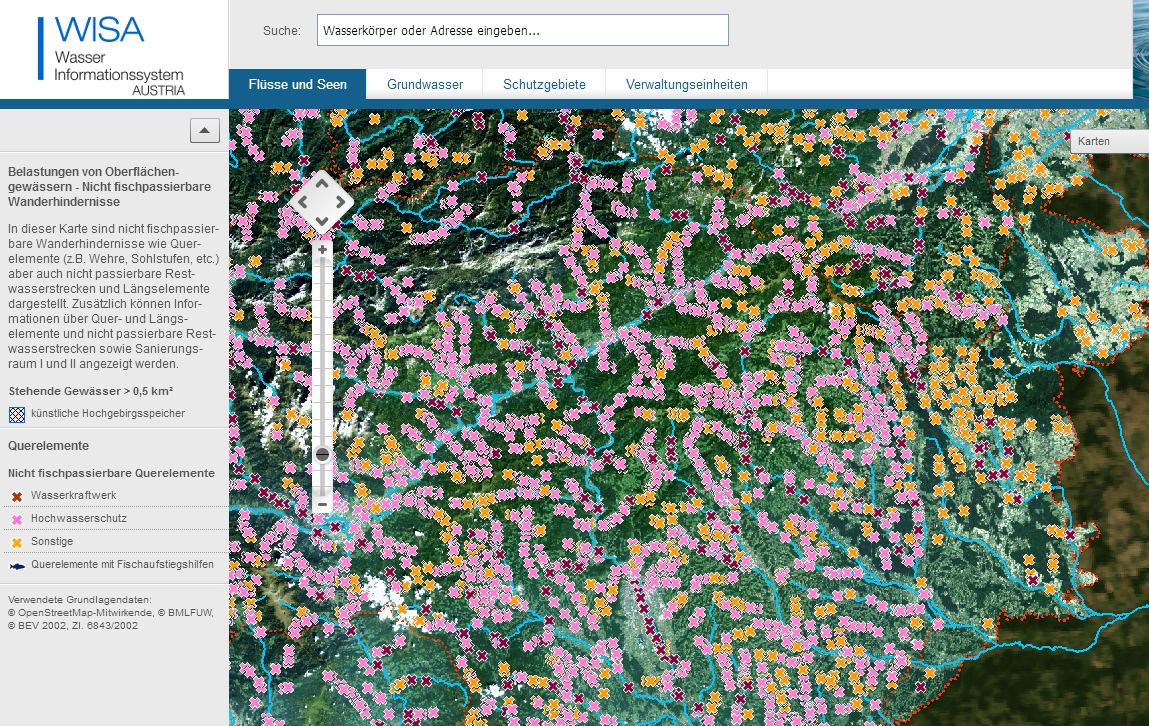 In Austria there are around 34,000 barriers in river networks with a catchment area greater than 10 km². Out of these, 2800 are small hydropower plants, the majority of which (70%) is not equipped with fish ladders. Currently, barrier mapping surveys are implemented in different regions of Austria and it is likely that the number of barriers will increase as small rivers will also be included in the surveys. In the frame of the implementation of the National River Basin Management Plan 2009, about 1000 barriers were opened for fish migration. As dam removal has not yet been implemented in Austria on a large scale, the majority of obstacles were equipped with fish ladders and only a small portion of weirs and sills was actually removed. The high density of fish barriers (a barrier per every kilometer) has led to the extinction of all long distance migration fish species and nearly all (12 out of 14) mid distance migration fish species have been listed as endangered fish species. (NGP 2015)
In Austria there are around 34,000 barriers in river networks with a catchment area greater than 10 km². Out of these, 2800 are small hydropower plants, the majority of which (70%) is not equipped with fish ladders. Currently, barrier mapping surveys are implemented in different regions of Austria and it is likely that the number of barriers will increase as small rivers will also be included in the surveys. In the frame of the implementation of the National River Basin Management Plan 2009, about 1000 barriers were opened for fish migration. As dam removal has not yet been implemented in Austria on a large scale, the majority of obstacles were equipped with fish ladders and only a small portion of weirs and sills was actually removed. The high density of fish barriers (a barrier per every kilometer) has led to the extinction of all long distance migration fish species and nearly all (12 out of 14) mid distance migration fish species have been listed as endangered fish species. (NGP 2015)
Switzerland
In Switzerland, there are approximately 100,000 artificial barriers above 50 cm in height (FOEN 2010b). Out of these, 538 are large hydropower plants and approximately 1,060 small hydropower plants. The average length of an unobstructed stretch of river is 650 m, with the number of barriers per river – kilometer ranging between two (Canton Bern) to eleven (Canton Zurich). Eight species (fish and lamprey species excluding whitefish) have become extinct. Furthermore over 30 % of known whitefish species have become extinct. (EAWAG, 2010, EEA report 2012)
France
In France, more than 60,000 structures — dams, locks, weirs and mills — have been recorded in the national barrier database. It is estimated that the river networks are affected by a total of 120,000 transversal structures. In some catchments such as the Upper Rhine and Rhône River, the density of obstacles is extremely high, with more than 200 obstacles per km². (ONEMA 2011, EEA report 2012)
Database on existing barriers in Europe
The World Fish Migration Foundation and WWF from the European Dam Removal movement are participating in the AMBER– Adaptive Management of Barriers in European Rivers Programme. One of the principle outputs of AMBER is to develop an European obstacle atlas in order to establish a common framework for barrier mapping. This data set can be used as a working basis in search for suitable dam removal candidates.
AMBER project site: http://amber.international/


